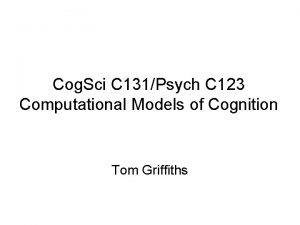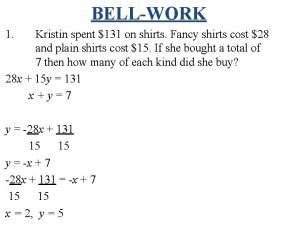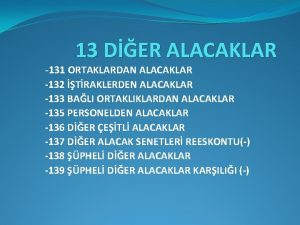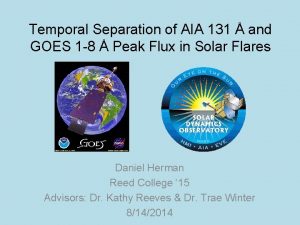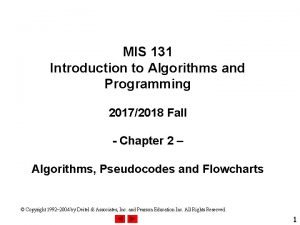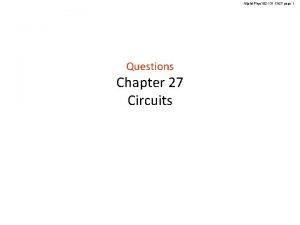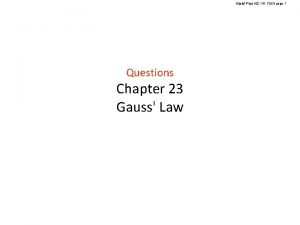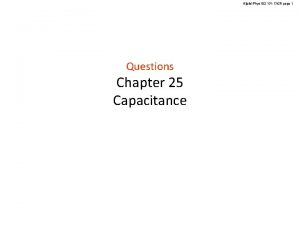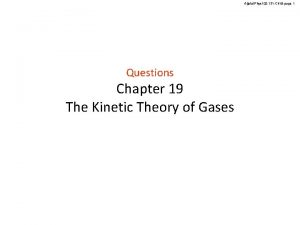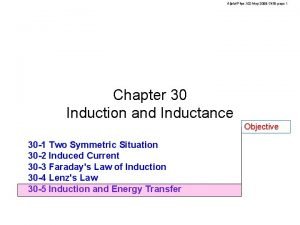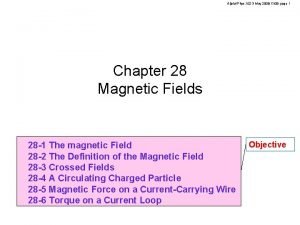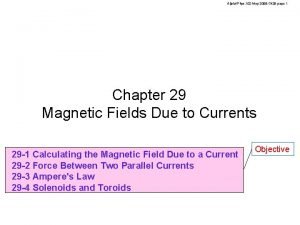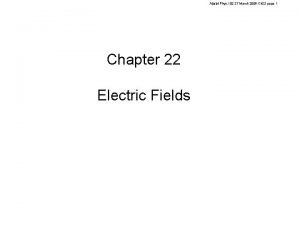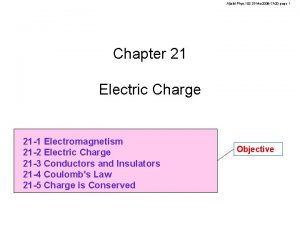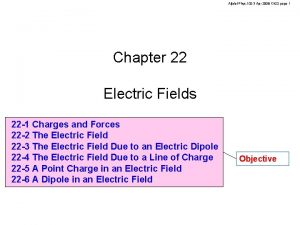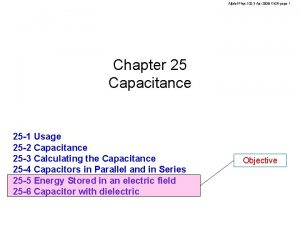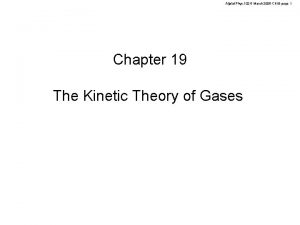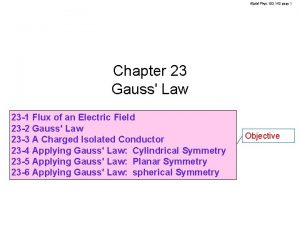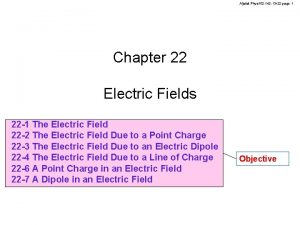AljalalPhys 102 131 Ch 24 page 1 Questions



















- Slides: 19

Aljalal-Phys 102 -131 -Ch 24 -page 1 Questions Chapter 24 Electric Potential

24 -4 Calculating the potential from the field Aljalal-Phys 102 -131 -Ch 24 -page 2 A proton is released from rest in a uniform electric field of magnitude 8. 0× 10 4 V/m directed along the positive x-axis. The proton undergoes a displacement of 0. 50 m along the direction of the field. Calculate the change in the potential energy of the proton. A) − 40 ke. V B) 40 ke. V C) − 20 ke. V D) 20 ke. V E) Zero Answer A

24 -4 Calculating the potential from the field Aljalal-Phys 102 -131 -Ch 24 -page 3

24 -4 Calculating the potential from the field Aljalal-Phys 102 -131 -Ch 24 -page 4 A charge of +28 n. C is placed at the origin in a uniform electric field that is directed along the positive y-axis and has a magnitude of 4. 0 × 104 V/m. The work done by the electric field when the charge moves to the point (3. 0 m, 4. 0 m) is: A) +4. 5 m. J B) +6. 0 m. J C) +3. 4 m. J D) – 4. 5 m. J E) – 6. 0 m. J Answer A

24 -4 Calculating the potential from the field Aljalal-Phys 102 -131 -Ch 24 -page 5

24 -5 Potential Due to a Point Charge Aljalal-Phys 102 -131 -Ch 24 -page 6 Eight isolated identical spherical raindrops are each at a potential of 100 V at the surface, relative to the potential at infinity. They are combined together to make one spherical raindrop whose potential at the surface is: A) 400 V B) 200 V C) 600 V D) 800 V E) 100 V Answer A

24 -5 Potential Due to a Point Charge Aljalal-Phys 102 -131 -Ch 24 -page 7

24 -5 Potential Due to a Point Charge Aljalal-Phys 102 -131 -Ch 24 -page 8 A non-conducting solid sphere of radius R = 10. 0 cm has a uniformly distributed charge Q = +1. 50× 10− 6 C. Find the magnitude of the potential difference between a point at r = 50. 0 cm and a point on the surface of the sphere. A) 108 k. V B) 207 k. V C) 98. 0 k. V D) 340 k. V E) 42. 0 k. V Answer A

24 -5 Potential Due to a Point Charge Aljalal-Phys 102 -131 -Ch 24 -page 9

24 -5 Potential Due to a Point Charge Aljalal-Phys 102 -131 -Ch 24 -page 10 An electron is projected with an initial kinetic energy of 3. 6 × 10 -24 J toward a fixed proton. If the electron is initially infinitely far from the proton, at what distance from the proton is its speed equal to twice its initial speed? A) 2. 9 μm B) 16 μm C) 83 μm D) 21 μm E) 3. 8 μm Answer D

24 -5 Potential Due to a Point Charge Aljalal-Phys 102 -131 -Ch 24 -page 11

24 -6 Potential Due to a group of Point Charges Aljalal-Phys 102 -131 -Ch 24 -page 12 Point charges q and Q are placed as shown in Fig. 4. If q = +2. 0 n. C and Q = -2. 0 n. C, a = 3. 0 m, and b = 4. 0 m, what is the electric potential difference (VA-VB)? A) 4. 8 V B) 6. 0 V C) -7. 2 V D) 8. 4 V E) 0 V Answer A

24 -6 Potential Due to a group of Point Charges Aljalal-Phys 102 -131 -Ch 24 -page 13

24 -7 Calculating the field from the potential Aljalal-Phys 102 -131 -Ch 24 -page 14 An electron is placed in an xy plane where the electric potential depends on x and y as shown in Figure 4 (the potential does not depend on z). What is the electric field (in units of k. V/m)? A) 5 î – 2 ĵ B) 5 î + 2 ĵ C) – 5 î + 2 ĵ D) 5 î + ĵ E) 10 î – ĵ Answer A

24 -7 Calculating the field from the potential Aljalal-Phys 102 -131 -Ch 24 -page 15

24 -8 Electric Potential Energy of a System of Point Charges Aljalal-Phys 102 -131 -Ch 24 -page 16 Two charges q = + 2. 0 μC are fixed a distance 2 d = 2. 0 cm apart (see Figure 5). With V = 0 at infinity, how much work needs to be done by an external agent to move one of the charges to point C? A) + 0. 75 J B) – 0. 75 J C) + 3. 6 J D) – 3. 6 J E) + 37 J Answer A

24 -8 Electric Potential Energy of a System of Point Charges Aljalal-Phys 102 -131 -Ch 24 -page 17

24 -9 Potential of a Charged Isolated Conductor Aljalal-Phys 102 -131 -Ch 24 -page 18 An isolated conducting sphere has radius R = 0. 20 m and a charge of +20 μC. Point A is at a distance of 3 R from the center of the sphere. If VC is the electric potential at the center of the sphere, what is the electric potential difference VC – VA? A) +6. 0 × 105 V B) – 6. 0 × 105 V C) +1. 2 × 107 V D) – 3. 0 × 105 V E) +3. 0 × 105 V Answer A

24 -9 Potential of a Charged Isolated Conductor Aljalal-Phys 102 -131 -Ch 24 -page 19
 Apa format header
Apa format header Phy 131 past papers
Phy 131 past papers Art. 131 cpc
Art. 131 cpc Um relogio feito a 50 anos foi fabricado com ponteiros
Um relogio feito a 50 anos foi fabricado com ponteiros Cog sci 131
Cog sci 131 Cmsc 131
Cmsc 131 Kristin spent $131 on shirts answers
Kristin spent $131 on shirts answers 13 diğer alacaklar
13 diğer alacaklar Salmo 131 2
Salmo 131 2 Aia 131
Aia 131 Buderus logano s 131-14
Buderus logano s 131-14 Phy 131 asu
Phy 131 asu Sjsu cmpe 131
Sjsu cmpe 131 Hmn 131
Hmn 131 Could 131g of xenon gas in a vessel
Could 131g of xenon gas in a vessel Mis 131
Mis 131 Mis 131
Mis 131 Hpd 136 uitm
Hpd 136 uitm Psalm 131 vers 4
Psalm 131 vers 4 Pp 131
Pp 131




